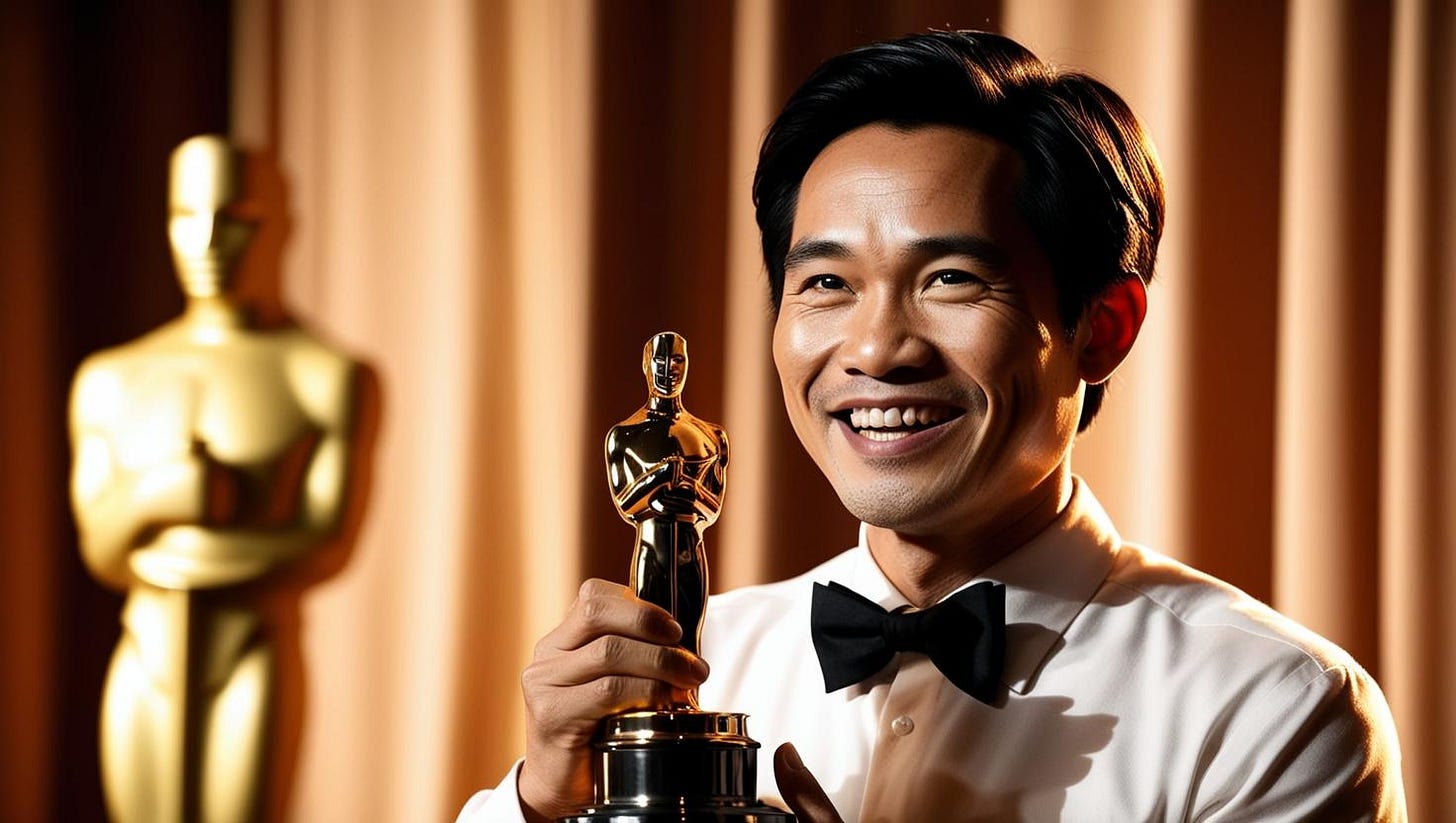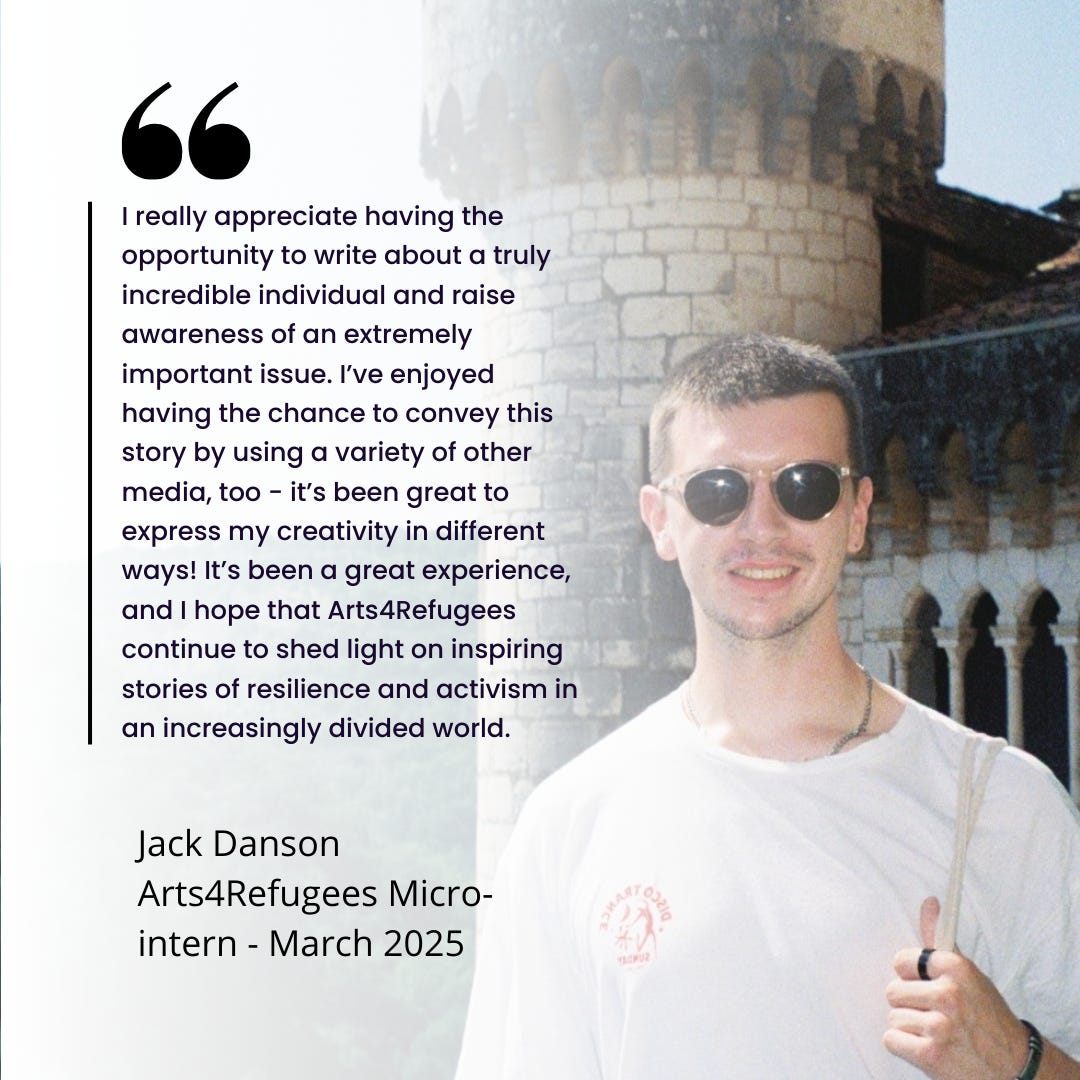Insects to Oscars: His Story Demands We Remember Cambodia's Pain. ✨💔
Read, Listen, Play & learn about Haing Ngor's arty refugee experience 🎮
Click here to play & learn.
Back Story
It’s the 25th March, 1985, and Haing S. Ngor—not for the first time—finds himself in a completely unprecedented scenario. To this point, his life had been marked by twists and turns, joyful peaks and devastating troughs, but it is unlikely that even he could have foreseen standing on stage at the Dorothy Chandler Pavilion, Los Angeles, accepting the Academy Award for Best Supporting Actor for his performance in The Killing Fields.
His acceptance speech starts off like many others, expressing gratitude to his co-stars and the film crew, until he mentions Warner Bros. whom he thanks for helping him tell his story and letting “the world know what happened in [his] country”. You see, the most incredible aspect of Ngor’s Oscar win is not that he was the first non-professional actor to come away with an award since the 1940s, or that he became the first Asian to scoop the Best Supporting Actor gong. It’s that he was still alive at this point in time.
Ngor was born in 1940 to a Khmer mother and a father with Chinese heritage. He grew up in the village of Samrong Yong, while Cambodia was still part of French Indochina. Ngor was an excellent student and earned the chance to study medicine at a French lycée in his country’s capital city, Phnom Penh. There, he specialised as an obstetrician and gynaecologist and eventually garnered enough success to open his own practice.
In the meantime, Cambodia found itself in crisis. The country declared its independence in 1953 after French decolonisation but was dragged into the Vietnam war by the United States, despite being a neutral country. In particular, President Richard Nixon and his National Security Advisor, Henry Kissinger, carried out bombings on Cambodian territory, where they believed North Vietnamese units to be covertly stationed.
Between 30,000 and 150,000 Cambodian civilians and soldiers are estimated to have died as a result of the strikes, but the worst was yet to come. First, a military coup led by Marshal Lon Nal deposed Prince Sihanouk as Cambodian head of state in 1970. Nal was a militaristic and nationalist leader, who envisioned an ethnostate of Khmer people. He preyed on the fear of a possible North Vietnamese invasion to drive up military recruitment and sparked the massacre of Cambodia’s Vietnamese population. On 15th April, after government planes had dropped leaflets from the sky over Phnom Penh about a historic massacre of Vietnamese people on Cambodian soil, people standing on the banks of the Mekong watched over 400 Vietnamese corpses float past (Source: The New York Times).
Change would come in 1975. While Ngor continued to have success as a clinician, Cambodia’s Communist Party, known as the Khmer Rouge, seized the capital and overthrew Nal’s government with the help of North Vietnam. The Khmer Rouge, led by Pol Pot, were even more brutal than their predecessors, however, and set the darkest period of Cambodian history in motion, with widespread persecution and torture for anyone who didn’t align with their principles.
Ngor was directly affected by such suppressive attitudes. The Khmer Rouge demonised any people with intellectual background as part of their ‘Year Zero’ policy that aimed to annihilate all cultures and traditions within Cambodia and rebuild society from scratch. As a result, Ngor had to conceal his past as a physician, even going without his glasses - a sign of being educated under the Khmer Rouge - which could have brought about his death.
Ngor did not completely escape punishment, though - he was imprisoned numerous times during the regime. The conditions both in and outside of the prisons were dire, as the country’s infrastructure was crippled by Pol Pot’s reforms. The entire population–men, women, and children–were forced to do grueling manual labour six days a week, every week, surviving on little more than rice. As a result, disease and malnutrition ran rampant, and starvation pushed people to extreme measures. In his memoir Haing Ngor: A Cambodian Odyssey, Ngor explained how he used his medical knowledge to survive off beetles, scorpions, and termites.
The real tragedy of Ngor’s past relates to the fate of his relatives. His mother was sent to a labour camp in Cambodia’s dense jungle, and he watched his brother and father walk away from the rice farm that they were sent to, and towards their execution. When they were forced out of Phnom Penh, Ngor’s wife Chang My-Huoy was pregnant and went into labour two months prematurely. She required a caesarean section, but Ngor was unable to perform the operation with Khmer Rouge guards lurking outside, as a demonstration of his scientific background would threaten his whole family. Chang would pass away in Ngor’s arms, along with the couple’s unborn child.
Between 1975 and 1979, it is estimated that one and a half million Cambodians died, though that number could have been as high as two million, around 25% of the country’s population (Source: Heuveline). The Khmer Rouge regime collapsed in 1979, and Ngor fled the country along with his niece, crawling to a refugee camp in neighbouring Thailand. In 1980, they moved to Los Angeles, where his life would take yet another unexpected turn.
Ngor showed his commitment to helping those who had been displaced by the conflicts in Indochina before his meteoric rise to fame - one of the first jobs he got in the United States was at the Chinatown Service Center, helping refugees from Vietnam, Laos and his own country to find employment in their new home. Then, fate intervened. At a Cambodian wedding, he met Hollywood casting director Pat Golden, who was scouting for a role in an upcoming film about the atrocities that Ngor had lived through. After months of reluctance and mixed feelings, Ngor finally auditioned for the part in 1983. Later that year, production started for The Killing Fields - with Ngor playing the role of Cambodian photographer and journalist, Dith Pran.
Pran’s life overlaps with Ngor’s in many ways: Both had been in Phnom Penh when it was seized by the Khmer Rouge, both had to conceal their education, both escaped the wrath of the regime by traversing treacherous routes to Thailand, and both used their experiences to spread awareness of the crisis in their motherland. While watching The Killing Fields, it’s clear to see how Ngor channeled his own traumatic experiences and his commonality with Pran - the memory of the atrocities that he had to endure is etched on his face throughout the film.
The Killing Fields was lauded by critics upon its release, but it was Ngor who was the real standout, a fact that is reflected in the plaudits he earned. He won people’s hearts with his story of resilience and survival in the face of unimaginable trauma, a process which culminated in his Oscar victory.
Ngor’s story doesn’t stop there, though. After alluding to his desire to bring the suffering of the Cambodian people to light, his activism didn’t cease after winning the most prestigious award the film industry has to offer. Despite many suggesting that Ngor had the acting chops to get any role after The Killing Fields, he would end up taking a number of comparatively smaller roles in order to guarantee money–which he would subsequently send back to those still struggling in Cambodia–, as well as keep him in the limelight, where he continued to strive for justice. Documentarian Arthur Dong noted that he got the impression Ngor never wanted to further his acting career, only to keep offering support to his compatriots.
Ngor was tragically murdered outside his home in California in 1996, but his legacy as a humanitarian lives on. Winning the Oscar for The Killing Fields may well be the crowning achievement of Ngor’s acting career, but what preceded and came after it was more significant in the context of his life, and indeed of his country’s history. His involvement with the Cambodian community of Los Angeles, as well as back in his homeland, was marked by a commitment to justice and a selflessness that is hard to come by nowadays. He will live on as an icon of activism, and ensured that those affected by one of the darkest episodes of human history would not be completely forgotten or abandoned by the world that was complicit in their suffering.
Bibliography:
Eisenberg, Carloyn Woods, Fire and Rain: Nixon, Kissinger, and the Wars in Southeast Asia, 2023.
Heuveline, Patrick, ‘The Demographic Analysis of Mortality Crises: The Case of Cambodia, 1970–1979’ in Forced Migration and Mortality, 102-129
‘Hundreds of Bodies of Vietnamese Seen in Cambodian River’, The New York Times, 16th April 1970.
Kiernan, Ben and Taylor Owen, ‘Making More Enemies than We Kill? Calculating U.S. Bomb Tonnages Dropped on Laos and Cambodia, and Weighing Their Implications’ in Japan Focus 13.17, 2015.
Kim, Hyung-chan, Stephen Fugita and Dorothy C.L. Cordova, ‘Haing Ngor’ in Distinguished Asian Americans: A Biographical Dictionary, 1999, 264–265.
Ngor, Haing and Roger Warner, Haing Ngor: A Cambodian Odyssey, 1987.
‘Remembering Haing Ngor, The First Asian To Win Best Supporting Actor — For 'The Killing Fields' In 1985’, LAist, 10th March 2023.
In this post Jack highlights the arty refugee experience of Haing Ngor. He is a citizen journalist on a placement with us organised by Oxford University Career Services. He also organised the micro game to make the journalistic experience interactive.
Thank you for reading an A4R 🎨 Post. Don’t forget to visit our gift shop here. Every purchase scales our impact and pays our bills.





